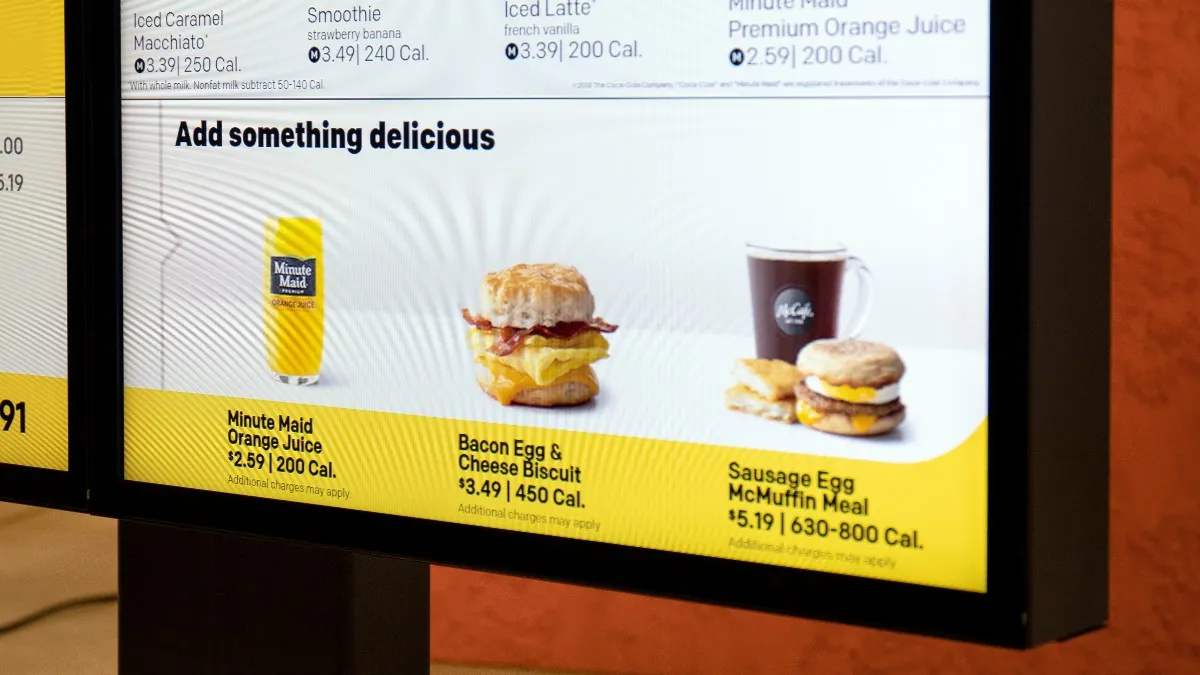Dive Brief:
- McDonald's shaved 20 seconds off its drive-thru times year-over-year and customer satisfaction was at an all-time high during the third quarter, CEO Steve Easterbrook told investors during a Tuesday call with investors.
- Some of its drive-thru initiatives included installing drive-thru timers in about 60% of its U.S. system, adding tools in the kitchen to help crews prepare food faster and reducing the complexity of the menu, he said.
- Dynamic Yield’s technology, which offers different menu options depending on the day, weather and popular menu items, has been deployed to over 9,500 McDonald's drive-thrus in the U.S. The entire U.S. system will have these outdoor digital menus by year's end. The technology will also be available across all Australian drive-thrus by the end of the year.
Dive Insight:
Drive-thru times have been a particular focus for McDonald's this year, with drive-thru times increasing in recent years due to the addition of fresh beef quarter pounders, all-day breakfast and premium products that take longer to make. The company has turned to technology alongside menu simplification, which included cutting premium items and trimming its late-night menu, to improve speed of service and the overall experience.
But it is just getting started in deploying tech at the drive-thru, and already seeing improvements in average check. Dynamic Yield's suggestive sales capabilities adjust depending on how a customer is ordering at the drive-thru, providing items the customer will more likely order, Easterbrook said. The chain expects additional opportunities when it deploys popular items within the menu and is scoping out additional markets where this tech would work. McDonald's also has plans to deploy Dynamic Yield's technology to its self-order kiosks and global app, Easterbrook said.
McDonald's doesn't plan to use the menu boards to adopt dynamic pricing models, preferring to have more consistent pricing, which is in line with the company's desire to offer reliability for customers so they know how much their meals or combos will cost each visit, Easterbrook said.
Drive-thrus could also soon have voice automation, which Easterbrook called a "must win," and one of the reasons why the company acquired Apprente. The addition of Apprente talent and technology will lead to the creation of more efficient and accurate drive-thru orders, which will help improve customer experience, he said, adding the technology is also expected to reduce complexity for crew members.
The improvements of speed of service, are particularly meaningful, especially since it has one of the consistently low drive-thru times in the country, according to data from QSR Magazine. McDonald's drive-thru times average about 284 seconds, but its vehicles in line are among the highest, second to Chick-fil-A. About 9% of McDonald's drive-thrus have six or more cars, and over one third have three to five.
Long lines can negatively impact overall traffic, which has been down for McDonald's U.S. during the last few quarters, with customers preferring to go elsewhere. Improving speed of service will help guarantee a continual stream of cars, and improved traffic.
"Customers will notice 20 seconds, particularly the time-pressed customers, [during] the busy peak hours, whether that is the breakfast rush or lunch hour," Easterbrook said of McDonald's 20-second reduction of drive-thru times. "Those savings they won't necessarily notice it on one visit. But as we consistently run better restaurants, we believe that will ultimately put us in a strong competitive position going forward."












